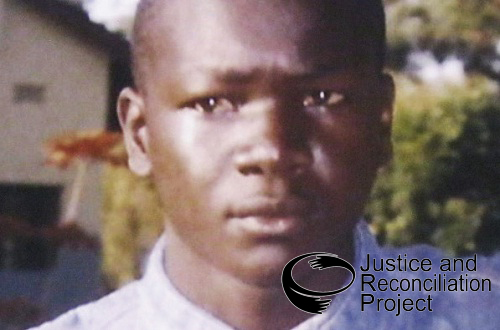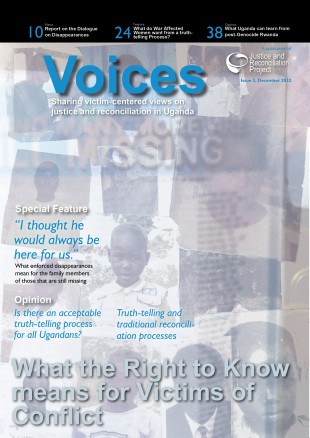Finding the Truth for Families of Persons Still Missing as a Result of Conflict in Northern Uganda
By Sylvia Opinia
One evening while finalising the preparations for the Dialogue on Disappearances
to commemorate the International Day Against Enforced Disappearances on 30th August 2012, we pinned up posters made by JRP in collaboration with Children/Youth as Peace Builders (CAP) Uganda, as an indicative list of missing persons in Gulu District. The waiter who brought our drinks suddenly stood there for some time while skimming through the names and finally asked one of my colleagues how he could get the name of his missing relative to be included on the poster. What caught my attention was not the question but the fact that in Northern Uganda almost every family has or knows of a family member who is missing.
Neville Wachibra for instance, is Norah Fathum’s eldest son. He went missing after an attack on a Nile coach bus on 19th September 2002 along Karuma – Packwach road just before he began his first year at Makerere University. To this day, Norah does not know the whereabouts of her son while the younger brother Emmanuel has to cope with the trauma of losing his role model at a young age. Julius Odonget is the son of Robert and Anna Okanya of Obalanga sub-county, Amuria District in Teso sub-region. In 2003, Julius was abducted with his sister after the LRA entered Teso through Obalanga. His sister managed to escape from captivity but Julius’ whereabouts remain unknown. Josephine and Bua Peter also lost their son Maxwell Ayo. Today they continue to hope to find his remains so that they can conduct a proper burial for him.
Evelyn Amony’s daughter, born in captivity, went missing after fighting between the UPDF and the LRA broke out in Sudan. Rumoured to have been taken by the UPDF, Evelyn’s daughter remains separated from her mother. Martin Ononge talks passionately about his son in law and his son who joined Alice Lakwena’s Holy Spirit Movement to fight but were arrested by NRA soldiers and taken to the prison where they were forced to dig without adequate amounts of food to eat. After two years, some of the people that were arrested with them came back, but his son and son-in-law have still not returned. Ononge up to date continues to search for his missing son and son-in-law.
These and many similar stories are told from West Nile, Acholi, Lango and Teso sub regions, of loved ones who disappeared during the height of the conflict in Northern Uganda. Amidst the immense post conflict challenges, those whose relatives are still missing and/or unaccounted for continue to seek answers to the whereabouts of their loved ones yet the issue of those who disappeared during the conflict has not made it to the national agenda.
The International Committee of the Red Cross (ICRC) defines missing persons as all those whose families are without news of them and/or are reported missing, on the basis of reliable information, owing to armed conflict. These include those disappeared by the state or taken by armed groups, children forcibly recruited or adopted, combatants missing in action and those in clandestine detention. It goes further to classify that in addition to the direct victim of disappearance, the families of the missing are its victims. In Northern Uganda, civilians have disappeared in the hands of both government and rebel forces. Though the magnitude (numbers of those missing) is not known, recent studies conducted by CAP, a local NGO working in the Acholi sub-region, indicates that in Gulu district alone, those who are still missing account for 29.5% of the total number of abductions by the LRA. Yet apart from local community based initiatives to search for their loved ones, at national level, no interventions have been put in place to deal with this major concern.
The ICRC, Amnesty International, the International Convention for the Protection of all People from Enforced Disappearances and the Rome Statute among others have gone further to justify that indeed knowledge about the whereabouts or establishing facts about what happened to their loved ones is a right for the families of the disappeared, as well the first step towards a process of seeking redress for their missing relatives. In our studies on truth-telling (see the series of JRP publications on www.justiceandreconciliation.com), we were able to find out that indeed people want to know something about what happened to their missing persons, siblings, children and spouses. Right from 1986 when the LRA/GoU conflict started, we have heard stories of people gone missing, to be unaccounted for either by state security agents or by the rebels, to date victims have remained silent but not silent because they are happy but because they have not been given the opportunity to come out and express their grievances about their loved ones gone missing.
Bringing the issues of accountability and reconciliation on the national agenda at Juba and the consequent developments within JLOS has been a milestone worth applauding. However, the next milestone is, are these issues going to be particular to those who were affected? Are they going to address the real victims who still suffer to date? What about missing persons, are they going to be fully incorporated into our proposed transitional justice (TJ) policy being generated by JLOS. Are we going to pretend to develop a TJ process that does not look at the issue of those who are still missing? That at the end of the TJ process will we have achieved anything if thousands of families in Northern Uganda still do not know the whereabouts of those who have gone missing?
Much as one can argue in theory, that all the TJ mechanisms can play a role in one way or the other to address the issue of missing persons, it is important to note that this begs for special and adequate consideration for a well facilitated justice mechanism based on the right truth and relevant information. So the question of missing persons remains an integral component of a truth-telling process in Uganda. Ideally when speaking about truth-telling, one fundamental aspect that ought not to be ignored for the case of Northern Uganda is the question “where is the missing person?” Take for instance abductions of plenty of children and adults, those who served as foot soldiers in the LRA, how many were they? Though we do not have actual figures, they constituted a big number of the population who are either killed or disappeared. Formerly Abducted Persons have come back without a detailed account of where their colleagues who were in the rebellion are. We need a mechanism where these issues are brought to our attention for us to get to know their whereabouts and who is responsible.
Hence for any TJ process and a truth-telling process for this matter to be meaningful, these are issues to be confronted with. We still remain optimistic that something will be done, that finally the government, the NRA/UPDF will come out and say “look this is what happened to those who were abducted; that your children whom we did not protect are languishing in the jungles of DRC or they have actually died in our hands and we should move forward as a nation and heal the wounds of those who still think that tomorrow their loved ones will be back or they will locate their remains”. These are issues that need to be addressed at that level.
This however can only be possible if the key stakeholders especially the GoU formally acknowledge the fact that this is a problem that requires intervention by putting it on the policy agenda. JRP through its “Right to Know Campaign” has created a platform for families and relatives of the missing to explore and situate the concerns and anguish of families/relatives of missing persons. We hope that this campaign will heighten awareness and draw the attention of the GoU, CSOs, donor community and the public about the missing or people who are unaccounted for as a result of conflict and the anguish of their families.
It’s therefore my passionate appeal to all key stakeholders especially the civil society fraternity, that the missing person is a very crucial area that we as practitioners in Northern Uganda must begin paying attention to. It is our role to garner the support of victims and other like-minded CSOs to begin looking at these issues and push them to the agenda of government. As a way forward, I challenge that we work together to embrace the issue, generate momentum and raise hope in the victims who are still searching for answers and/or healing. This is the time for closure for victims and for CSOs to become a relevant force to reckon with the past that these victims have been through. ▪
Sylvia Opinia is the Team Leader for JRP’s Community Mobilisation Department.















